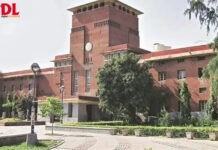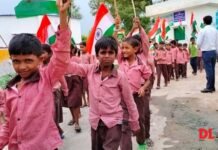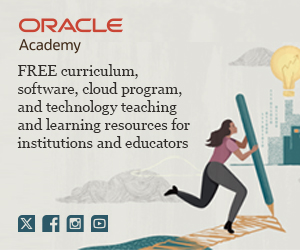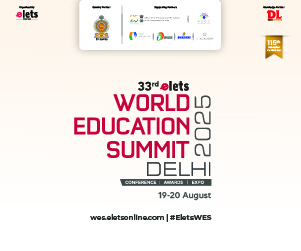There is an acute shortage of teaching staff in the higher education institutions of Gujarat, revealed the report of the Comptroller and Auditor General of India (CAG). It was also revealed that 60 per cent institutions providing higher and technical have not obtained NAAC/NBA accreditation which results in lack of quality education. No mechanism was evolved to bridge the gap through recruitment even though the teacher/student ratio was so low in government and grant-in-aid colleges, observes the report. It also mentioned that persistent shortage will have adverse implications on the quality of teaching. The CAG report also mentions that scrutiny of records had revealed that out of 10 universities and 899 institutions in the higher education sector, only five universities and 345 institutions had obtained accreditation from NAAC as of May 2010. And worse, they had not even applied for accreditation. According to the report, the teacher/student ratio for non-technical courses in Gujarat has gone from bad to worse. The ratio of 1:50 in 2006-07 worsened to 1:57 in 2008-09. As per the norms of University Grant Commission (UGC), the ratio should be 1:30. Moreover, out of 293 technical institutions, only 117 had obtained NBA accreditation and 43 institutions had failed to renew the same after expiry, added the report. The CAG report has also brought to notice that the government did not set up a teachers' training university to bring uniformity in the standards of teaching in higher education despite availability of Rs6.95 crore. Moreover, a knowledge consortium and a knowledge corporation were not activated due to lack of planning. Besides, assistance of Rs3.28 crore from UGC and AICTE was not availed due to non-execution of work, non-payment of staff as per UGC norms, delay in disbursement of funds and non-observance of AICTE instructions. The CAG report also mentions that the Digital English Language Laboratory (DELL) project, created at a cost of Rs18.12 crore, was not fully utilised and failed to achieve its objective of promotion of English language through information and communication technology. Cases of non-disbursement or delay in disbursement of scholarships also came to notice. Thirty-five colleges of technical education did not have access to free e-journals and e-books under the Indian National Digital Library in Engineering Sciences and Technology (INDEST) programme and thus benefits of e-libraries could not be passed on to the students, said the report.
Mizoram, Tripura become literacy front-runners amid terror stricken past
The two most terrorism hit states of north east; Tripura and Mizoram, have now become the crusaders of India's literacy movement. Literacy level in Mizoram is 91.58 percent and 87.75 percent in Tripura, says the data for the 2011 census. They are only behind Kerala (93.91 percent), which continues to occupy the top position in the literacy chart. The national literacy rate is 74.04 percent. The second most literate state in the country, Mizoram's literacy rate has gone up from 88.49 percent to 91.58 percent. Female literacy stands at 89.40 percent of the 538,675 women and male literacy at 93.72 percent of 552,339 men. In the 2001 Census, Mizoram's literacy rate was 88.49 percent. “Serchhip district (98.76 percent) in northern Mizoram and Aizawl district (98.50 percent) have recorded highest literacy rates among all districts in India,” a census official in Aizawl said. The Christian missionaries and the influential NGO – Young Mizo Association (YMA) – are the main promoters of education in the mountainous Mizoram, which witnessed over a decade of terrorism till 1986. “The missionaries introduced the Roman script for the Mizo language and formal education. The cumulative result is the present high percentage of literacy in the state, bordering Myanmar and Bangladesh,” he added. The Tripura success story is attributed to the involvement of local government bodies, including gram panchayats, NGOs and clubs. “Our efforts are on to achieve 100 percent literacy in Tripura,” told Education Minister Tapan Chakraborty. Had there been no militancy, he added, Tripura would have attained 100 percent literacy long back. “Education and development have been affected due to terrorism in the state until 2009,” he stated. Senior census official Dilip Acherjee said in Agartala: “In Tripura, increase of female literacy is better than their male counterparts.” “The literacy rate of Tripura has gone up from 73.19 percent (of the total 3.1 million population) in 2001 Census to 87.75 percent (of the total of 3.6 million population) in the 2011 Census, showing an increase of 14.56 percent,” he said. “Interestingly, literacy rate of females during the same period rose from 64.91 to 83.15 percent with an increase of 18.24 percent while in case of male the increase was just 11.18 percent — from 81 to 92.18 percent,” Acharjee said. While Mizoram and Tripura are among the toppers in literacy in India, another northeastern state Arunachal Pradesh (66.95 percent) placed the second lowest position in literacy in the country after Bihar (63.82 percent).
Transcending Barriers: Inclusive Education in the context of Open Schooling
National Institute of Open Schooling (NIOS), an autonomous organisation under the Ministry of Human Resource Development (MHRD), Govt. of India organised a two-day seminar Transcending Barriers – Inclusive Education in the Context of Open Schooling at India Habitat Centre on March 8-9, 2011. With the motto of “Supporting inclusion, challenging exclusion”, the dates were symbolically chosen to coincide with the 100th year of International Women's Day because even today, women are a marginalised group and need to be consciously included in all streams of life, more so in education. Dr. S.S. Jena, Chairman, NIOS was the Conference Chairman; Dr. Kuldeep Agarwal, Director (Academic), NIOS was the Conference Director; and Ms. Asheema Singh, NIOS was the Conference Coordinator. The objective of the seminar was to establish that the fundamental principles of open distance education are based on 'inclusive education' including diversities arising from gender, age, nationality, race, language, social background, level of educational achievement, disability etc. It aimed at exploring the achievement of 'Barrier Free Education' which is unprejudiced and supportive in all forms. Conducted over two days, the seminar touched upon many serious issues like Cultural and Disability Barriers, Socio-Economic Barriers and Initiatives (exploring the value of innovative techniques for inclusive education). Under “Breaking Barriers”, papers on Life Skills for Life-Long Learning were presented. A session on “Voices from Within” was based on shared learning through discussions on success stories from learners, parents & other care givers. All the participants actively contributed in drawing the Road Map for inclusive education through open schooling in the session “Constructing New Possibilities”. The seminar was inaugurated by Sh SC Khuntia, Joint Secretary, MHRD Govt of India, while Mr. A. Parsuraman, Director and representative from UNESCO was the Guest of Honour. The keynote address was delivered by Dr. Rukmini Banerjee, Director PRATHAM. The Guest of Honour of the valedictory session was Dr. Marc Derveeuw, Country Representative A.I., UNFPA, India. Welcoming the guests, Dr. S.S. Jena said that Education is the key to all development. Keeping the huge number of out of school children in mind, conventional schooling may not be adequate to meet the national aspirations of 'Education for All' (EFA). This has necessitated the promotion of Open and Distance Learning (ODL) approach as an alternative system. The cost effectiveness and wide outreach are some of the salient features of this system. Since its inception in 1989, the National Institute of Open Schooling (NIOS), has enrolled 1.6 million learners, and is the largest Open school in the world. It offers Academic, Vocational and Life Enrichment courses at the Senior Secondary, Secondary and the Elementary level through 3700 Study Centres. Dr. Kuldeep Agarwal, while introducing the seminar, said that it was organised to strengthen the outreach, inclusion of all and exclusion of none. He said that NIOS has taken a big step forward to partner with and network with several like-minded individuals and organisations. He thanked Expressions India, Prayas and Tamana for the technical support. Dr. Shankar Chowdhary, National Professional Officer, UNESCO, Ms. Usha Ram, Principal, Laxman Public School, Mr. Amod Kanth, Chairperson, Delhi Commission for Protection of Child Rights, (DCPCR), Dr. Sushmita Mitra, Director Student Support System (SSS), NIOS, Mr. Vinod Raina from Eklavya, Dr. Shyama Chona, President Tamana, Ms. Madhu Ranjan from USAID, Ms Geeta Narayan, Programme Officer from UNFPA, Mrs. Mridula Seth from Lady Irwin College, Prof Frank Banks, Director IDTE, UK Open University, Dr. Jitendra Nagpal, Program Director, Expressions India, Dr. S.S. Jena, Dr. Kuldeep Agarwal, Dr. Huma Masood, Education Specialist from UNESCO were amongst the many luminaries who chaired or co-chaired the sessions.
Stanford joins hands with Jaslok Hospital
To study possibilities of cooperation in medical services and training Stanford Medical Centre, an Ivy League institution in San Francisco, and Jaslok Hospital and Research Centre in Mumbai have signed an MoU. Stanford will provide the initial phase Teleconferencing Programmes to Jaslok doctors with top class education on “hot topics” to in turn offer best therapeutic options to Indian patients. There would also be opportunities to participate interactively with Stanford presenting and attending faculties. This could be expanded in later phases with visitations by Jaslok doctors to hospitals and clinics at Stanford and its affiliate hospitals in the US. “I firmly believe that Jaslok Hospital's multispeciality doctors will benefit greatly by educational engagement with world renowned faculty from one of US top Ivy league institutions like Stanford Medical Centre,” Dr. Mukesh Hariawala, Boston based Indian American Cardiac Surgeon, told the media. “At Jaslok, we plan to establish a 'Centre for Excellence' in cutting edge medical technologies like Angiogenesis and Stem Cells for Cardiovascular Diseases. Receiving guidance from Stanford would be key to successful execution,” Hariawala who leads Jaslok's International Partnerships Development Programme said. Leading the Stanford team will be Dr Yann Meunier, Director of Business Development, Stanford International Medical Services, who will oversee the complete development of the teleconferencing series of lectures. “We are delighted with this educational partnership with India's Jaslok Hospital and Research Centre. The best renowned Stanford faculty will be included in the Programmes,” Meunier said. “We have developed teleconferencing series to which Jaslok Hospital will participate such as Cardiovascular Diseases, the Aging Patient and many more.” “We also look forward to strengthening the long term relationships with Jaslok Hospital with newer joint programmes in the future which can be shared across different platforms to other participating Asian country partners,” he said. Hariawala will be the official conduit to collate monthly feedback from all participants at Jaslok and convey to Stanford management for future content and programme development with suggestions that would be of greater value to Jaslok doctors. The initial projects will be related to cardiovascular medicine and geriatric or age related medicine and its associated diseases. The first teleconference session is planned for May. Initially a monthly event it may be expanded to bi-monthly in the second phase at the time of MoU's renewal after 18 months.
7th -National Student Management Quiz competition (NSMQ)
The recognition of excellence has been a key factor in AIMAs' thinking over the years. One such initiative is 'National Student Management Quiz' (NSMQ) for students of Business Schools. Mr. Kamal Singh, CMD, AIMA said, “As a part of its endeavor, AIMA offers a series of events of national importance; several of these have created a critical mass of leadership in the management calendar of the country and are eagerly awaited by the management community. 'Sachin Ravi' and 'Raghav' from Symbiosis Business School were the winners of the NSMQ 2011 finale this year. NSMQ is primarily for students from Business Schools, which aim to provide a unique opportunity to budding student managers for demonstrating knowledge, creativity and professional prowess thereby showcasing their strength besides creating a healthy spirit of competitiveness amongst the Business Schools in the country. The Chief Guest Mr. Amar Prasad, ED, KRIBHCO & the Guest of Honor Mr. Rajiv Sahdev, VP
Google tries hands in science fair, promotes products
Google, the search engine giant, with its first Google Science Fair, is getting into the science fair business. A global competition for teenagers that spans sciences as diverse as computer engineering, space exploration and medical technology. The event is still unnamed and does not have deep roots into the topic like its competitors Intel or Siemens. But Google stands out as it's most familiar among children as compared to the other three. With the science fair, Google aims to play an even bigger role in their lives by encouraging young scientists to experiment – and to use Google products while they're at it. Google's science fair is different from the others in a major way: Entrants submit their projects online, using Google products like Gmail, YouTube and Google Docs and Sites. It's the modern-day version of showing up at the school gymnasium to demonstrate lava-spewing volcanoes or bacteria colonies in petri dishes. It also serves another purpose. By putting its products in the hands of budding scientists, Google is trying to make its brand central to students' lives, just as Nike does when it outfits top high school football teams. Vint Cerf, chief Internet evangelist at Google and a science fair judge, insists that Google's motivation is not to attract long-term customers. “The real motivation is to help stimulate kids' interest in science and technology, and we hope infect other parts of the population in their excitement,” he said. Google has struggled to make inroads into offices, where Microsoft software still rules. If Google convinces high school students that its products – for example, SketchUp, Google Body or Google Goggles – are useful, they could use them at work later on. Their mission is also part of a broader one to improve science and math education in the United States. Participation in science fairs nationwide has tapered off, largely because teachers facing budget cuts and overcrowded classrooms lack the time and resources to coach students. Google winners will attend an awards ceremony at the company's headquarters in Mountain View, Calif., and receive a trip to the Galapagos with National Geographic, a week with astrophysicists at CERN or an internship at Lego.
Chandigarh schools bid adieu to blackboards
It's time for change in the schools of Chandigarh. It's time to say bye to the traditional chalk-and-talk method and go for the hi-tech multimedia labs. All the laboratories of Chandigarh schools will be computerised and have latest technological tools to aid in teaching English, Hindi and mathematics. To implement the project Sarva Siksha Abhiyan has roped in the Regional Institute of English, Chandigarh. “Multimedia labs in schools will be equipped with 16 computers, 15 for the students and one for the teacher. To make them familiar with this innovative way of teaching, all teachers of these seven schools are being imparted training,” the official added. Initially, the multimedia labs will come up at seven government schools. Once the project is implemented successfully, all schools will boast of multimedia labs. The lab for training at the Regional Institute has 31 computers, hi-tech software and an LCD projector, giving the teachers a feeling of a virtual classroom. “The UT Education Department has plans to introduce multimedia labs in 20 more schools. For this, proposals have been made in the annual budget,” an Education Department official said. As many as 45 teachers are being trained. Before the new session begins in April, all of them will be ready to operate multimedia labs, he further said. The media labs will facilitate computerised listening, speaking and writing. The virtual programme will give the students an option to decide their own rate of speed to learn their lessons,” the official informed.
Everonn reports decent financial growth, projects promising future
Everonn, the market leader of ICT in education, has posted a 72% CAGR growth in its topline over the past five years. The government's proposal to increase spending on vocational training across the country and the company's new initiatives to expand its market presence are likely to keep the growth momentum strong. Also, it has reported a consistent improvement in its operating margin. However, uncertain cash flows from its new subsidiaries and fragmented nature of the industry continue to be a concern. Everonn continues to report a decent financial growth over the quarters. During the 12 months ended December 2010, the company's revenue and net profit grew by over 75% each. But its operating margin dropped by 100 basis points (bps) due to the fluctuating operating costs. However, profitability is once again improving. During the December 2010 quarter, operating margin expanded by 300 bps sequentially to 38.1%. The company has invested nearly Rs 40 crore towards its two new subsidiaries funded through internal accruals. During the December 2010 quarter, while the existing subsidiaries reported a decent growth in revenues, the new subsidiaries reported a 76% drop in its EBIDTA. However, the businesses are likely to break even in coming quarters. At the current market price of Rs 568.9, the stock trades at 18.7 times its earnings for the trailing 12 months. The company's future growth looks promising, given its initiatives and the government's thrust on mass education.
Corporate funding new expansion strategy for IIM-C
Indian Institute of Management- Calcutta (Kolkata) has now found a new source of funding from the corporates rather than going for privatizing. IIM-C's chairman of the board of governors Ajit Balakrishnan on Saturday, during the institute's 46th annual convocation, said “under any circumstances, we are not in favour of privatisation of IIMs. We favour corporate contribution for new IIMs as they may not be in a position to generate resources adequately at least in the initial years.” “It is possible to create a corpus outside the government. But entrepreneurs must be allowed to get full tax benefit of the total contribution,” he said. “Currently, Indian tax system does not allow us to create a corpus,” he added. Balakrishnan said the government should also allow tax reduction for a couple of years at the market value from income if a corporate institution contributed to any educational institute, as was done in the US. Earlier, speaking on the occasion, IIM-C director Shekhar Chaudhuri said the institute will soon launch an online general management certificate programme in collaboration with top financial schools. “The IIM-C is providing full support to the new IIM Ranchi, which has been set up six months ago. Most of the courses there are taught by our faculty,” he added.



















